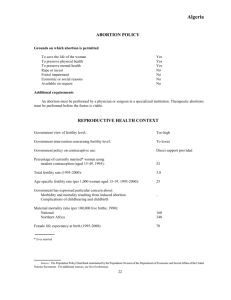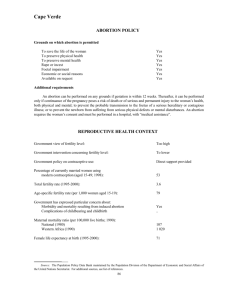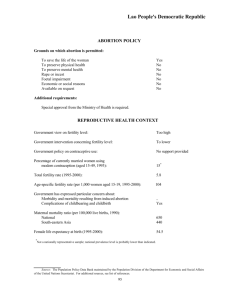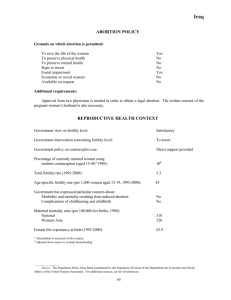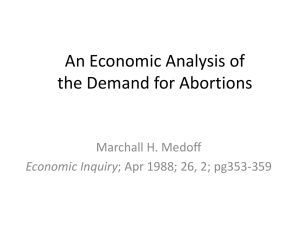Sri Lanka - the United Nations
advertisement
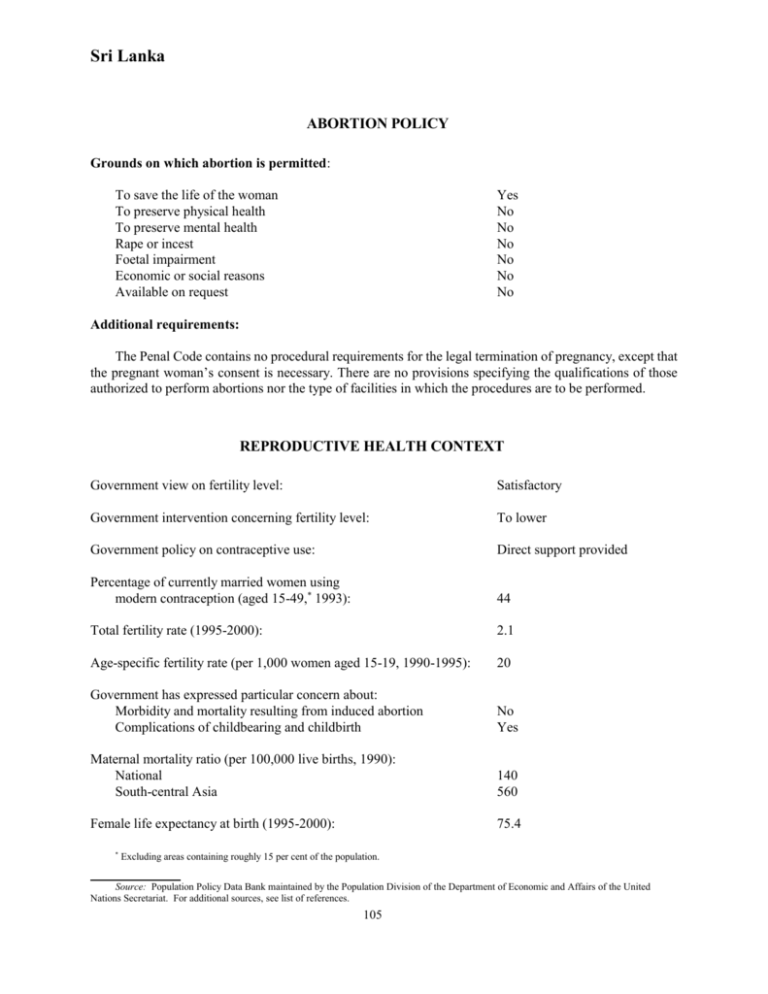
Sri Lanka ABORTION POLICY Grounds on which abortion is permitted: To save the life of the woman To preserve physical health To preserve mental health Rape or incest Foetal impairment Economic or social reasons Available on request Yes No No No No No No Additional requirements: The Penal Code contains no procedural requirements for the legal termination of pregnancy, except that the pregnant woman’s consent is necessary. There are no provisions specifying the qualifications of those authorized to perform abortions nor the type of facilities in which the procedures are to be performed. REPRODUCTIVE HEALTH CONTEXT Government view on fertility level: Satisfactory Government intervention concerning fertility level: To lower Government policy on contraceptive use: Direct support provided Percentage of currently married women using modern contraception (aged 15-49,* 1993): 44 Total fertility rate (1995-2000): 2.1 Age-specific fertility rate (per 1,000 women aged 15-19, 1990-1995): 20 Government has expressed particular concern about: Morbidity and mortality resulting from induced abortion Complications of childbearing and childbirth No Yes Maternal mortality ratio (per 100,000 live births, 1990): National South-central Asia 140 560 Female life expectancy at birth (1995-2000): 75.4 * Excluding areas containing roughly 15 per cent of the population. Source: Population Policy Data Bank maintained by the Population Division of the Department of Economic and Affairs of the United Nations Secretariat. For additional sources, see list of references. 105 Sri Lanka BACKGROUND Abortion is generally illegal in Sri Lanka under the Penal Code of 1883, which is based on the Indian Penal Code. Section 303 of the Penal Code provides that anyone voluntarily causing a woman with child to miscarry is subject to up to three years’ imprisonment and/or payment of a fine, unless the miscarriage was caused in good faith in order to save the life of the mother. The penalty is imprisonment for up to seven years and payment of a fine if the woman is “quick with child”, a term which, while not defined in the Code, refers to an advanced stage of pregnancy when there is perception of foetal movement, as opposed to “woman with child”, which simply refers to “being pregnant”. A woman who induces her own miscarriage is subject to the same penalties. If the miscarriage is caused without the consent of the woman, whether or not she is quick with child, the person causing it is subject to up to 20 years’ imprisonment and payment of a fine (Section 304). The same penalty is imposed if the woman’s death results from any act carried out with intent to bring about a miscarriage, whether or not the offender knew that the act was likely to cause death (Section 305). In 1973, the abortion legislation of the country was studied by a committee of the Medical Legal Society of Sri Lanka, which recommended that the law should be liberalized to allow abortions to be performed to prevent grave injury to the physical and mental health of the mother, in cases where pregnancy resulted from rape or incest, and in cases where there was substantial risk that the child, if born, would suffer from severe physical or mental abnormalities that would cause it to be seriously handicapped for life. No legislative action, however, resulted from these recommendations. The Ministry of Health has begun, however, to publicize the linkage between illegal abortion and maternal mortality as a means of giving support to a liberalization of the abortion law. Despite rigid statutory provisions, Sri Lankan women from higher income households who desire to terminate their pregnancies find little or no difficulty in doing so. They often consult a psychiatrist for severe mental depression combined with suicidal tendencies. The psychiatrist may advise an abortion in order to save the life of the mother, and the pregnancy may then be terminated in a private or government hospital by a qualified medical practitioner. Women from middle-income and lower income households, however, must often resort to abortions performed by “back-door abortionists” under primitive and unhygienic conditions, resulting in high maternal mortality and chronic ill health. Although any abortion wilfully induced without the specific intent to save the life of the mother constitutes illegal abortion in Sri Lanka, in practice, indictments for criminal abortion rarely occur and convictions are even rarer. The incidence of abortion is believed to be considerably higher than is commonly acknowledged. A rural survey suggests that 54 abortions per 1,000 population are performed each year. The Government of Sri Lanka considers the rates of fertility and population growth to be too high and hoped to achieve a target of replacement-level fertility by the year 2000. Sri Lanka has a current total fertility rate of 2.1 children per woman and a population growth rate of 1 per cent, a rate satisfactory to the Government. Recognizing that a reduction in fertility will enhance socio-economic development, the Government has sought to strengthen and expand the delivery of family planning services, to provide incentives for controlling population growth and to promote population education. Family planning services are part of a comprehensive family health programme that provides a variety of subsidized clinical and contraceptive services. Existing maternal and child health and family planning services are being enhanced, especially in rural and poor urban areas. The modern contraceptive prevalence rate was estimated at 44 per cent in 1993. Local health officials estimated the 1999 maternal mortality rate to be 250 deaths per 100,000 live births, 25 per cent of them related to unsafe abortions. Source: Population Policy Data Bank maintained by the Population Division of the Department of Economic and Social Affairs of the United Nations Secretariat. For additional sources, see list of references. 106


